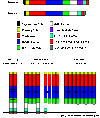Meprin A metalloproteinase and its role in acute kidney injury
- PMID: 23427141
- PMCID: PMC3651633
- DOI: 10.1152/ajprenal.00014.2013
Meprin A metalloproteinase and its role in acute kidney injury
Abstract
Meprin A, composed of α- and β-subunits, is a membrane-associated neutral metalloendoprotease that belongs to the astacin family of zinc endopeptidases. It was first discovered as an azocasein and benzoyl-l-tyrosyl-p-aminobenzoic acid hydrolase in the brush-border membranes of proximal tubules and intestines. Meprin isoforms are now found to be widely distributed in various organs (kidney, intestines, leukocytes, skin, bladder, and a variety of cancer cells) and are capable of hydrolyzing and processing a large number of substrates, including extracellular matrix proteins, cytokines, adherens junction proteins, hormones, bioactive peptides, and cell surface proteins. The ability of meprin A to cleave various substrates sheds new light on the functional properties of this enzyme, including matrix remodeling, inflammation, and cell-cell and cell-matrix processes. Following ischemia-reperfusion (IR)- and cisplatin-induced acute kidney injury (AKI), meprin A is redistributed toward the basolateral plasma membrane, and the cleaved form of meprin A is excreted in the urine. These studies suggest that altered localization and shedding of meprin A in places other than the apical membranes may be deleterious in vivo in acute tubular injury. These studies also provide new insight into the importance of a sheddase involved in the release of membrane-associated meprin A under pathological conditions. Meprin A is injurious to the kidney during AKI, as meprin A-knockout mice and meprin inhibition provide protective roles and improve renal function. Meprin A, therefore, plays an important role in AKI and potentially is a unique target for therapeutic intervention during AKI.
Keywords: acute kidney injury; meprin; metalloproteinase; renal proximal tubule.
Figures


References
-
- Becker C, Kruse MN, Slotty KA, Köhler D, Harris JR, Rösmann S, Sterchi EE, Stöcker W. Differences in the activation mechanism between the alpha and beta subunits of human meprin. Biol Chem 384: 825–831, 2003 - PubMed
-
- Becker-Pauly C, Howel M, Walker T, Vlad A, Aufenvenne K, Oji V, Lottaz D, Sterchi EE, Debela M, Magdolen V, Traupe H, Stocker W. The alpha and beta subunits of the metalloprotease meprin are expressed in separate layers of human epidermis, revealing different functions in keratinocyte proliferation and differentiation. J Invest Dermatol 127: 1115–11252115, 2007 - PubMed
Publication types
MeSH terms
Substances
Grants and funding
LinkOut - more resources
Full Text Sources
Other Literature Sources
Molecular Biology Databases

